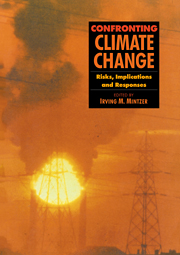Book contents
- Frontmatter
- Contents
- Foreword
- Acknowledgements
- List of Reviewers
- 1 Living in a Warming World
- I The Science of Climate Change
- 2 Linkages Between Global Warming, Ozone Depletion, Acid Deposition and Other Aspects of Global Environmental Change
- 3 Climate Sensitivity, Climate Feedbacks and Policy Implications
- 4 Lessons from the Ice Cores: Rapid Climate Changes During the Last 160,000 Years
- 5 Changes in Climates of the Past: Lessons for the Future
- 6 Indices and Indicators of Climate Change: Issues of Detection, Validation and Climate Sensitivity
- II Impacts of Global Climate Change
- III Energy Use and Technology
- IV Economics and the Role of Institutions
- V Equity Considerations and Future Negotiations
- Annex I
- Annex II
- Glossary
- Index
4 - Lessons from the Ice Cores: Rapid Climate Changes During the Last 160,000 Years
Published online by Cambridge University Press: 06 January 2010
- Frontmatter
- Contents
- Foreword
- Acknowledgements
- List of Reviewers
- 1 Living in a Warming World
- I The Science of Climate Change
- 2 Linkages Between Global Warming, Ozone Depletion, Acid Deposition and Other Aspects of Global Environmental Change
- 3 Climate Sensitivity, Climate Feedbacks and Policy Implications
- 4 Lessons from the Ice Cores: Rapid Climate Changes During the Last 160,000 Years
- 5 Changes in Climates of the Past: Lessons for the Future
- 6 Indices and Indicators of Climate Change: Issues of Detection, Validation and Climate Sensitivity
- II Impacts of Global Climate Change
- III Energy Use and Technology
- IV Economics and the Role of Institutions
- V Equity Considerations and Future Negotiations
- Annex I
- Annex II
- Glossary
- Index
Summary
Editor's Introduction
As snow accumulates in the perpetually cold areas of Greenland and Antarctica, air collects in small hollow pockets within the ice. Over time, the ice closes over and the air is permanently trapped beneath the surface. Advanced techniques of isotopic analysis—similar to those discussed by Michael McElroy in the following chapter — reveal important information about the chemical composition of the atmosphere and the average surface temperatures, at the time when the ice closed over the air pockets. Comparing ice core samples taken in Greenland and the Antarctic, Hans Oeschger and Irving Mintzer report the evidence, just emerging now, of large and rapid climate fluctuations in the past, and suggest that the dynamic mechanisms that drove the planet through the great changes of the distant past could be repeated in the not-too-distant future.
For example, ice cores from the Camp Century and Dye 3 sites in Greenland indicate that, during the last major glacial to inter-glacial transition approximately 13,000 years ago, climate in the North Atlantic region appears to have fluctuated between two very different, meta-stable states. Analysis of oxygen isotopes in marine sediments suggests that one state supported a quite mild climate, approximately 5°C warmer, on average, than the other. The transitions between these two states may have taken place in periods lasting less than 100 years.
As part of the analysis of ice core records, Oeschger and others have recently applied a new mathematical technique called a deconvolution algorithm. Application of this technique to the ice cores reveals the history of carbon dioxide concentrations over very long periods.
- Type
- Chapter
- Information
- Confronting Climate ChangeRisks, Implications and Responses, pp. 55 - 64Publisher: Cambridge University PressPrint publication year: 1992
- 1
- Cited by

